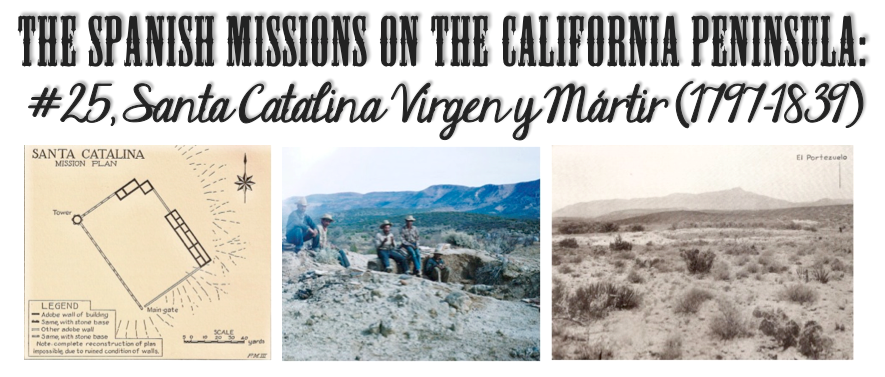
By David Kier
www.vivabaja.com
Co-author of ‘The Old Missions of Baja & Alta California, 1697-1834’
The Mission Santa Catalina story begins with the actions of Padre Juan Crisóstomo Gómez while serving as Dominican President from 1790 to 1793. Padre Gómez had recently completed the construction of the great stone church of Mission San Ignacio, and also had practiced immunization to halt the spread of disease among the Indians. Gómez authorized three mountain missions be founded to secure the inland areas of the northern peninsula and to Christianize the natives. Immediately after the founding of the first mountain mission at San Pedro Mártir, the search for the second mission site began in the region instructed by the Viceroy.
In October of 1794, SergeantJosé Manuel Ruiz and Padre Tomás Valdellon examined the place named Santa Catalina midway between the mission of San Vicente and the Colorado River. The most important aspect of a mission site was a reliable year-round source of water. A year later, Ensign Alférez Bernal led an expedition and explored the region. Governor Borica provided Bernal with a list of ‘prime essentials’ a mission site must possess. The list included: a constant source of water, land for raising wheat and maize, near-by firewood and pasture, and numerous available heathen.
Lieutenant-Governor José Joaquín de Arrillaga, traveling north from his home in Loreto, left Mission San Vicente on September 5, 1796 to examine Santa Catalina and the route to the Colorado River. This was but one of four expeditions that year to determine if a land route to Sonora was feasible. Arrillaga had met hostile Indians at the Colorado River and returned to San Vicente by way of San Diego. In an October, 1797 letter, Arrillaga determined that a garrison of soldiers should be stationed in the delta region with a presidio at the head of the gulf and a detachment at Sonoita and San Felipe, thus securing a sea route of escape. The first order of business however, was to establish a mission at Santa Catalina.
The order for a new mission was placed by the Viceroy and the governor. The mission was to be strongly fortified as it was known to be in dangerous territory. Santa Catalina would also be the last mission built on the peninsula that was authorized by the Spanish government. No other mission site was so greatly researched by repeated expeditions than Santa Catalina.
Lieutenant-Governor Arrillaga had desired to separate California into two political districts, and his 1796 expedition was to be influential in that happening. Governor Borica also favored the plan, yet nothing of it came for several more years. Governor Borica died in July, 1800, shortly after leaving Alta California for Durango. Arrillaga was made governor but was allowed to remain at his residence in Loreto.
On August 6, 1797, building was begun at the future mission site for the church (33 feet by 17 feet), priest’s house (17 feet by 17 feet) and a gaurdhouse. November 12, 1797 was the day that Mission Santa Catalina Virgen y Mártir was officially founded by Padres José Loriente and Tomás Valdellon. It was the 7th Dominican California mission, the 25th mission on the peninsula, and the 42nd mission in all of California. The location was a place the natives called Jaca-Tobojol, which means “place where the water falls over stones”. The elevation at Santa Catalina is 3,900 feet above sea level.
In 1798, an adobe house with two rooms was built with each room measuring 14 feet by 17 feet. In 1799, another adobe house measuring 14 feet by 20 feet was constructed to serve as a shelter for girls and single women. Santa Catalina had a population of 133 Indians in 1800. Another house measuring 17 feet by 17 feet was also built that year. In 1802, an adobe structure with two rooms measuring 14 foot square was constructed and may have served as a workshop.
Eight Dominicans are named serving Santa Catalina, José Loriente in 1797, Tomás Valdellon in 1797 to 1804, Jacinto Fiol 1804-1807, Manuel de Aguila was stationed at the mission in 1808 and 1809. Antonio Fernández was assigned to Santa Catalina from 1809 to1810, and again from 1815 to 1817 from his post at San Vicente. José Duro was the priest from 1810 to 1811, followed by Manuel Saiz from 1811 to 1812. Padre Felix Caballero was perhaps the last Dominican in charge at Santa Catalina (1819-1839) and is named as such in an October 3, 1822 letter from Padre José Miguel de Pineda, of Mission Santo Tomás.
California was officially divided into two districts on March 26, 1804. Arrillaga was made governor of Upper (Alta) California, and Captain Felipe de Goycoechea was appointed to be governor of Lower (Baja) California. Alta California also was called Nueva (New) California, and Baja California was called Antigua (Old) California. These names (Nueva and Antigua) appeared on documents describing the two regions of California for many years. The idea for a third mountain mission, ordered by Padre Gómez, was abandoned.
In a letter written in Loreto on December 23, 1808, the Dominican Padre Ramon López wrote: “The two missions in the hills, Santa Catalina and San Pedro, cannot give what they don’t have. The minister at Santa Catalina formerly was able to send something, but now he struggles just to make ends meet.”
The population at Santa Catalina was reported as more than 600 in 1824 then down to 250 in 1834. This would have made Santa Catalina the most populous of the Dominican missions. In October of 1839, the Santa Catalina mission was attacked burned, and 16 neophytes were slain. Padre Caballero, nor any other Dominican, ever returned to rebuild Santa Catalina.
The walls have melted back to the ground leaving almost nothing to visualize the once important mission. Archeologists in recent years have excavated to the stone foundation at a corner of a mission room, and accurately mapped the site with sophisticated equipment. The Pai-pai Indians are still living near the mission. Their village is called Santa Catarina which is a slightly different spelling than the mission’s name.
To reach the Santa Catalina mission site by Santa Catarina, use the Ensenada-San Felipe highway (Mexico #3) and drive just south of Km. 91, in the town of Ejido de los Heroes de la Independencia. Go east, on a well graded dirt road. Near the 5 mile mark from Hwy. 3, take the fork to the right and go downhill, then work left through the little town of Santa Catarina soon going over a hill to the cemetery. Turn left and go up the hill, above the cemetery. The mission site is 5.6 miles from Highway 3.
GPS data and satellite views of the mission sites in Baja California can be seen at: http://vivabaja.com/missions4/
In the book, ‘The Old Missions of Baja & Alta California 1697-1834’ are the details of the establishment of all 48 California missions, in the order they were founded. The peninsula of California is home to 27 missions and the land north, that many years later became part of the United States, is home to 21 missions. There was just one California when all but the final five missions were founded. The final two missions were founded after Mexico won its independence from Spain. All 48 missions were abandoned before 1850 when (Alta) California became the 31st state of the United States.

The mission stone foundation, hidden underneath melted adobe walls, was exposed in 2007 by archeologist Lee Panich and his team.
David Kier is co-author of ‘The Old Missions of Baja & Alta California, 1697-1834’. The book is available for purchase HERE or at the DBTC offices (call 800-727-2252).

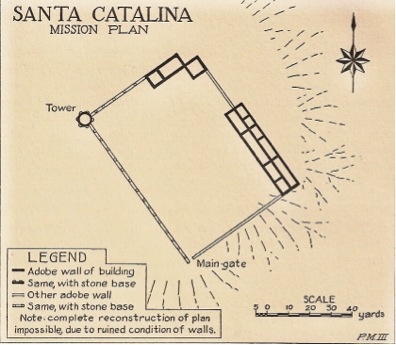
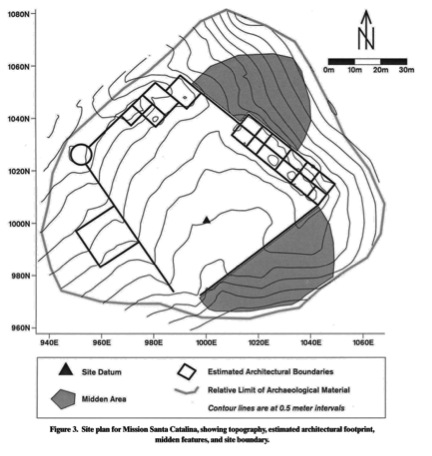
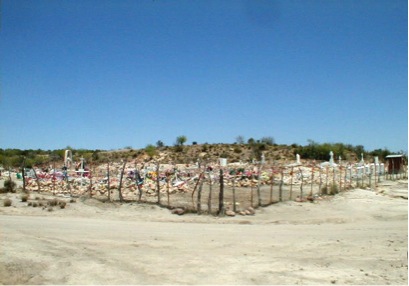
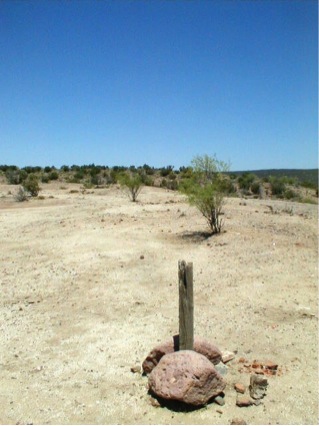
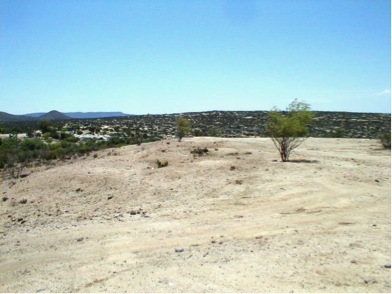
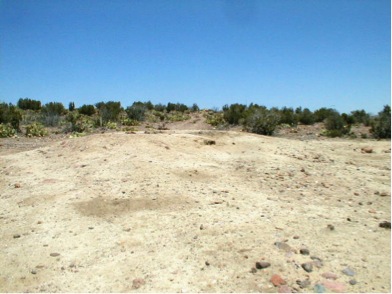
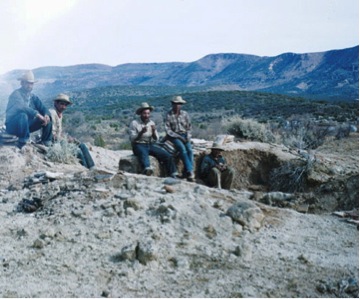
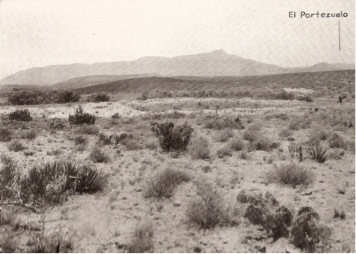
One thought on “The Spanish Missions on the California Peninsula: #25, Santa Catalina Virgen y Mártir (1797-1839)”